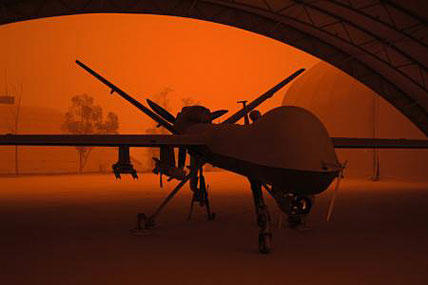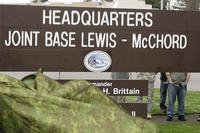Pentagon engineers want to make it easier for drones to exchange video feeds and sensor data between the service branches.
Military leaders plan to do this by aligning development of its next-generation drones with a specified set of technical standards and migrating more of its systems toward use of a standardized Common Data Link to transmit sensor information, officials said.
The idea is to facilitate more instances wherein, for example, a Navy unmanned aircraft system could fly over an island or coastal area while Army or Marine Corps forces on the ground view real-time Full Motion Video feeds from the aircraft's sensors using small, mobile Remote Video Terminals, Pentagon officials said.
This inter-service, real-time ability to share sensor data between different service-specific UAS on the move in combat is precisely what Pentagon UAS developers are rapidly moving toward.
"Today, the Air Force, Army, Navy can pass imagery around, but typically that occurs at the intel-center level. We want to push that further up the chain where it makes sense -- to maybe [Remote Video Terminals] or the ground station level," said Dyke D. Weatherington, director of Unmanned Warfare & ISR.
A soldier or Marine doesn't care so much what platform is providing the intelligence, the servicemember just wants it, Weatherington said.
"In Afghanistan, the theater commander does not care if it is a U2, Global Hawk, Reaper or RC-12. We want to put the architecture together that allows that data to move as quickly as possible," he said.
At the start of the Iraq war there were a handful of drones in existence. Now, the Air Force, Army, Navy, and Marine Corps each own and operate hundreds, in some cases thousands, of UAS with work continuing to develop many more next-generation platforms for the future.
The various service fleets range from large next-generation maritime UAS for aircraft carriers such as the Navy's Unmanned Carrier Launched Airborne Surveillance and Strike drone to the small, hand-launched Raven. According to Pentagon figures, the U.S. drone fleet approximately includes 7,200 Ravens, 939 Wasps, 1,125 Pumas, 499 Shadows, 100 Reapers, 34 Global Hawks, 18 Fire Scouts, and 194 Scan Eagles.
In 2007, then-Defense Secretary Robert Gates expressed his frustration with service leaders, especially the Air Force, over the lack of speed in which drones were shipped to Iraq and Afghanistan. The UAS Task Force was stood up soon after Gates told leaders about his complaints.
Over the last ten years, many UAS technologies were developed, acquired and deployed as Quick Reaction Capabilities, a program designed to deliver technology to deployed units while simultaneously aiding development for longer-term, more traditional acquisition efforts.
The UAS Task Force sees its efforts as a key way to best position the technological development of UAS for the future while continuing to meet the insatiable demand for intelligence, reconnaissance and surveillance and managing the exponentially-increasing fleet of UAS across the services, Weatherington explained.
Given the pace of the massive UAS expansion and acquisition over the last ten years, the Pentagon is now assessing the fleet with an eye on future threats and likely future operating environments. They are also looking to improve developmental integration and interoperability among service UAS' with a mind toward taking the proper strategic path into the future.
In fact, the UAS Task Force launched an unmanned systems interoperability initiative three years ago which identified as many as 29 gaps within DoD's inventory of UAS. Their work since that time has been oriented toward addressing these gaps and preparing for the future, he added.
In addition to creating common standards for FMV, the Pentagon's UAS Task Force is also making progress on developing protocol for standardizing the acquisition, technical development and weaponization of UAS across the services.
"We are hoping to move from reactive posture to pro-active posture. If we know where we want to be in three, five, seven years, then we can back that up and we can decide what the key decision points are at different points in time," Weatherington said.
One analyst said the Pentagon's future emphasis on the technological environment in which UAS will operate is well-placed.
"If there are a lot things to keep working on, one of them would be to be able to keep transmitting data in a more contested electromagnetic environment. We have not had to worry about that in the last 10 years. There's no reason to think we will always be able to share and downlink as easily as we have been," said Michael O'Hanlon, senior fellow at the Brookings Institution, a Washington D.C.-based think tank. "I'm talking about the possibility of data-downloads being jammed."
While moving toward the goal of better integrating UAS in concept and in practice is a real, measurable phenomenon, it does not easily come to fruition, Weatherington said. Greater "interoperability" among service-specific UAS technology and ISR platforms hinge upon the establishment and implementation of a specific set of technical standards, often referred to by developers as "architecture."
This architecture, Weatherington explained, consists of a common, agreed-upon set of standards or IP Prototcol involving certain IT specifications; these include things like computer code, taxonomy, metadata and messaging formats among other things.
"An advantage to building an architecture up front rather than building it after the fact is you can define up front what you want. IP protocol is a set of many standards," he said.
IP protocol, in IT terms, is the mechanism which helps identify and code data such that it can move through the transport layer from its origin to its destination.
In fact, with respect to the ability to view and share full motion video, the Defense Department is shaping the development, operation and evolution of UAS technology such that nearly all the services' UAS fleet now migrating quickly toward use of a standardized common data link (CDL) configuration, Weatherington said.
CDL is a family of waveforms that allow different systems to talk to each other. CDL capabilities range from relatively low data rates of a half-megabit or megabit per second -- up to very large data rates of 274 megabits per second, Weatherington said.
"Within the UAS Task Force, we've had a big effort to standardize FMV how we do that across the whole spectrum -- from the output of the sensor, through the compression -- through the data link on whatever frequency to a ground station where someone can decode and display," he explained.
CDL uses portions of the electromagnetic spectrum to move packets of information using waveforms, he explained. Therefore, moving toward more widespread use of a standardized CDL, a subset of which is often referred to as Tactical Common Data Link -- or TCDL, vastly increases the ability to share video feeds between otherwise "stove-piped" UAS and ISR systems, Weatherington added.
At the same time, configuring compression formats is also key to viewing FMV feeds on ground stations, mobile devices or Remote Video Terminals. The Army, for instance, uses large, truck-mounted Ground Control Stations (GCS) as well as small, mobile, laptop-like structures with antennas called One System Remote Video Terminals (OSRVT) for viewing FMV feeds on the move. The Air Force also uses viewing terminals as well as mobile hand-held units called the Rover.
"If you have a 10-megabit wave-length you can do FMV. You can probably go down to two-megabits and get FMV, so it all gets into quality. Everyone wants HD [high-definition] and simultaneous channels of HD. We are trying to figure out how to squeeze all that in, all the while you are trying to maintain a user base of Remote Video Terminals that can receive the same picture and do it in a seamless manner," said Richard Pino, director of Communications & Networks for the Pentagon's Acquisition, Technology and Logistics office.
Many of the service's UAS systems already utilize CDL such as the Army's Gray Eagle, the Air Force's Global Hawk and the Navy's maritime variant of the Global Hawk, the Triton. The Navy's Fire Scout vertical take-off-and-landing UAS is also configured to use CDL. The Army's Shadow and the Air Force's 66-foot wingspan Reaper UAS are slated to receive CDL through an upcoming technical upgrades, Weatherington said.
In addition, the Pentagon's UAS task force is currently working with the services to bring CDL to the Navy and Marine Corps' catapult-launched Scan Eagle UAS as well as the Corps' family of Small Tactical UAS. Although many of the multi-service hand-launched UAS such as the Puma, Raven and Wasp provide primarily point-to-point FMV capability to a nearby operator in a specific area, they could be integrated to CDL in the future as well.


























